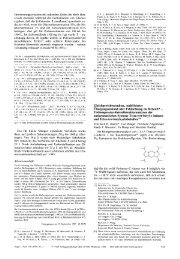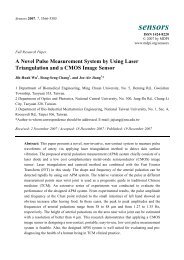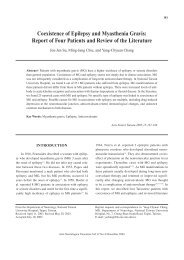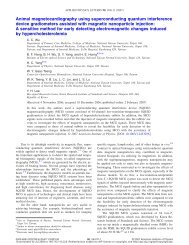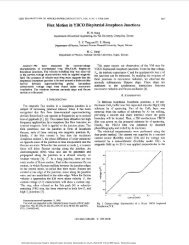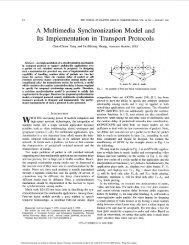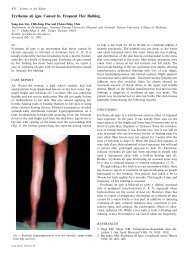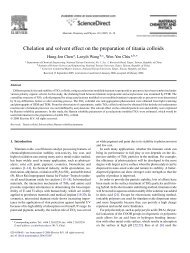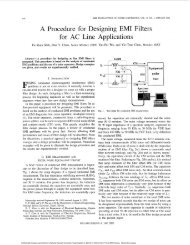A Protease Inhibitor of the Serpin Family Is a Major Protein in Carp ...
A Protease Inhibitor of the Serpin Family Is a Major Protein in Carp ...
A Protease Inhibitor of the Serpin Family Is a Major Protein in Carp ...
Create successful ePaper yourself
Turn your PDF publications into a flip-book with our unique Google optimized e-Paper software.
.Inuruul <strong>of</strong> Neurnchemi .rtry<br />
Raven Press, Lld ., New York<br />
© 1995 International Society tor Neurochemistry<br />
A <strong>Protease</strong> <strong>Inhibitor</strong> <strong>of</strong> <strong>the</strong> <strong>Serp<strong>in</strong></strong> <strong>Family</strong> <strong>Is</strong> a <strong>Major</strong> <strong>Prote<strong>in</strong></strong><br />
<strong>in</strong> <strong>Carp</strong> Perimen<strong>in</strong>geal Fluid : II . cDNA Clon<strong>in</strong>g, Sequence<br />
Analysis, and Escherichia coli Expression<br />
*Chang-Jen Huang, M<strong>in</strong>g-Shyue Lee, *Fore-Lien Huang, and Geen-Dong Chang<br />
*Institute <strong>of</strong> Biological Chemistry, Academia S<strong>in</strong>ica ; and yGraduate Institute <strong>of</strong> Biochemical Sciences and<br />
$Department <strong>of</strong> Zoology, National Taiwan University, Taipei, Taiwan<br />
Abstract : A cDNA clone, pCP9, has been isolated from<br />
a common carp liver cDNA library by immunoscreen<strong>in</strong>g<br />
with polyclonal antiserum raised aga<strong>in</strong>st purified bighead<br />
carp a,-antitryps<strong>in</strong> . This clone is 1,396 by <strong>in</strong> length and<br />
has an open read<strong>in</strong>g frame encod<strong>in</strong>g a prote<strong>in</strong> <strong>of</strong> 410<br />
am<strong>in</strong>o acid residues . The deduced am<strong>in</strong>o acid sequence<br />
shows moderate homology to human a,-antitryps<strong>in</strong><br />
(38%), gu<strong>in</strong>ea pig contraps<strong>in</strong> (35%), human a,-antichymotryps<strong>in</strong><br />
(34%), and human prote<strong>in</strong>ase C <strong>in</strong>hibitor<br />
(31 %), all members <strong>of</strong> <strong>the</strong> ser<strong>in</strong>e protease <strong>in</strong>hibitor (serp<strong>in</strong>)<br />
family . To confirm fur<strong>the</strong>r that <strong>the</strong> cDNA clone was<br />
derived from <strong>the</strong> au<strong>the</strong>ntic carp a,-antitryps<strong>in</strong> gene, <strong>the</strong><br />
presumptive mature prote<strong>in</strong> <strong>of</strong> pCP9 was expressed <strong>in</strong><br />
Escherichia coli. The molecular mass <strong>of</strong> <strong>the</strong> recomb<strong>in</strong>ant<br />
prote<strong>in</strong> matched that predicted from <strong>the</strong> nucleotide sequence<br />
. This recomb<strong>in</strong>ant prote<strong>in</strong>, which was recognized<br />
by antiserum aga<strong>in</strong>st native a,-antitryps<strong>in</strong>, was capable<br />
<strong>of</strong> formation <strong>of</strong> serpn-enzyme complexes with tryps<strong>in</strong>,<br />
chymotryps<strong>in</strong>, and elastase . Therefore, we conclude that<br />
<strong>the</strong> prote<strong>in</strong> encoded by <strong>the</strong> pCP9 clone is <strong>in</strong>deed carp<br />
a,-antitryps<strong>in</strong> . Expression <strong>of</strong> a,-antitryps<strong>in</strong> <strong>in</strong> bra<strong>in</strong> was<br />
confirmed by reverse transcription and polymerase cha<strong>in</strong><br />
reaction performed on mRNA derived from both common<br />
carp and bighead carp bra<strong>in</strong> . Key Words: <strong>Carp</strong>-<strong>Protease</strong><br />
<strong>in</strong>hibitor-<strong>Serp<strong>in</strong></strong>-Perimen<strong>in</strong>geal fluid .<br />
J. Neurochem . 64, 1721-1727 (1995) .<br />
The serp<strong>in</strong>s (ser<strong>in</strong>e prote<strong>in</strong>ase <strong>in</strong>hibitors) are a family<br />
<strong>of</strong> glycoprote<strong>in</strong>s that <strong>in</strong>clude members <strong>in</strong>volved <strong>in</strong><br />
<strong>the</strong> control <strong>of</strong> blood coagulation, fibr<strong>in</strong>olysis, complement<br />
activation, and <strong>in</strong>flammation processes (Carrell<br />
and Boswell, 1986) . Many <strong>of</strong> <strong>the</strong>m are plasma protease<br />
<strong>in</strong>hibitors syn<strong>the</strong>sized and secreted by <strong>the</strong> liver, such<br />
as a,-antitryps<strong>in</strong> (Long et al ., 1984), contraps<strong>in</strong> (Suzuki<br />
et al ., 1991), a l -antichymotryps<strong>in</strong> (Chandra et<br />
al ., 1983), complement C, <strong>in</strong>hibitor (Bock et al .,<br />
1986), and prote<strong>in</strong> C <strong>in</strong>hibitor (Suzuki et al ., 1987) .<br />
However, a few <strong>of</strong> <strong>the</strong>m are syn<strong>the</strong>sized <strong>in</strong> o<strong>the</strong>r tissues,<br />
such as elastase <strong>in</strong>hibitor (Remold-O'Donnell et<br />
al ., 1992), a,-antitryps<strong>in</strong> ( Perlmutter et al ., 1985 ; Perlmutter<br />
and Punsal, 1988), and complement C, <strong>in</strong>hibi-<br />
1721<br />
for (Bensa et al ., 1983) from monocytes, protease<br />
nex<strong>in</strong> from glial cells (Sommer et al ., 1987 ; Van Nostrand<br />
et al ., 1989), and plasm<strong>in</strong>ogen activator <strong>in</strong>hibitor<br />
from endo<strong>the</strong>lial cells (Ny et al ., 1986) .<br />
We have purified a 62-kDa protease <strong>in</strong>hibitor (p62)<br />
from bighead carp perimen<strong>in</strong>geal fluid (PMF) (Huang<br />
et al ., 1995 ) . p62 resembles mammalian a,-antitryps<strong>in</strong><br />
<strong>in</strong> many respects . The prote<strong>in</strong> forms complexes with<br />
and <strong>in</strong>hibits bov<strong>in</strong>e tryps<strong>in</strong>, bov<strong>in</strong>e chymotryps<strong>in</strong>, and<br />
porc<strong>in</strong>e pancreatic elastase . In addition, <strong>the</strong> protease<br />
<strong>in</strong>hibitor is a glycoprote<strong>in</strong> whose carbohydrate moiety<br />
can be removed by endoglycosidase F . Because a,antitryps<strong>in</strong><br />
<strong>in</strong> mammals is syn<strong>the</strong>sized and secreted<br />
from <strong>the</strong> liver, attempts were made to isolate cDNA<br />
clones encod<strong>in</strong>g this protease <strong>in</strong>hibitor from a carp<br />
liver cDNA library . We obta<strong>in</strong>ed two cDNAs whose<br />
expression products were recognized by a polyclonal<br />
antiserum aga<strong>in</strong>st pb2 . Evidence is provided to support<br />
<strong>the</strong> proposal that one <strong>of</strong> <strong>the</strong>se clones encodes functional<br />
p62 .<br />
MATERIALS AND METHODS<br />
Enzymes and chemicals<br />
Restriction enzymes, <strong>the</strong> Klenow fragment <strong>of</strong> DNA polymerase,<br />
and T4 DNA ligace were purchased from ei<strong>the</strong>r<br />
Promega (Madison, WI, U .S.A .) or Boehr<strong>in</strong>ger Mannheim<br />
(Mannheim, Germany) . Radiolabeled compounds were obta<strong>in</strong>ed<br />
from Amersham (Amersham, U.K .) . Sources <strong>of</strong> o<strong>the</strong>r<br />
chemicals were described <strong>in</strong> our preced<strong>in</strong>g article ( Huang<br />
et al ., 1995) .<br />
.<br />
Received April 15, 1994 ; revised manuscript received August 17,<br />
1994 ; accepted August 31, 1994 .<br />
Address correspondence and repr<strong>in</strong>t requests to Dr. C .-D Chang<br />
al Graduate Institute <strong>of</strong> Biochemical Sciences, National Taiwan University,<br />
P .O . Box 23-106, Taipei 10098, Taiwan .<br />
The sequence data <strong>in</strong> this article have been submitted to <strong>the</strong><br />
EMBL/Genbank Data Libraries<br />
L08689 and L27172 .<br />
under <strong>the</strong> accession numbers <strong>of</strong><br />
Abbreviations u.sect. PBS, phosphate-buffered sal<strong>in</strong>e ; PCR, polymerase<br />
cha<strong>in</strong> reaction ; PMF, perimen<strong>in</strong>geal fluid ; RT, reverse transcription<br />
; SDS, sodium dodecyl sulfate.
1722<br />
General methods <strong>in</strong> molecular biology<br />
Standard procedures <strong>in</strong> molecular biology (Sambrook et<br />
al ., 1989) were used for preparation <strong>of</strong> planmid DNA, restriction<br />
enzyme digestion, DNA agarose gel electrophoresis,<br />
DNA ligation, and bacterial transformation .<br />
lmmunoscreen<strong>in</strong>g <strong>of</strong> a carp liver cDNA library<br />
A carp liver (Cypr<strong>in</strong>us carpio) cDNA library prepared<br />
from poly(A)-enriched RNA by unidirectional <strong>in</strong>sertion <strong>of</strong><br />
cDNA <strong>in</strong>to A-ZAP II ( Short et al ., 1988 ) was purchased from<br />
Stratagene (La Jolla, CA, U.S .A .) . To screen <strong>the</strong> library, A-<br />
ZAP II phages were plated at a density <strong>of</strong> 5 X IO a plaques<br />
per agar plate (150 mm i .d .) . A total <strong>of</strong> 10 plates was <strong>in</strong>itially<br />
screened . After <strong>in</strong>cubation for 3 h at 42°C, <strong>the</strong> plates were<br />
overlaid with nitrocellulose filters (pore size, 0.45 p,m ; Micron<br />
Separations, Westboro, MA, U.S .A .) that had been impregnated<br />
with 10 mM isopropyl-ß-~-thiogalactopyranoside<br />
. Incubation was cont<strong>in</strong>ued overnight at 37°C . The filters<br />
were <strong>the</strong>n removed, washed wíth phosphate-buffered sal<strong>in</strong>e<br />
(PBS) at room temperature, and blocked <strong>in</strong> 3% skim milk<br />
<strong>in</strong> PBS for 1 h at room temperature. Follow<strong>in</strong>g block<strong>in</strong>g,<br />
filters were probed with a polyclonal antiserum specific for<br />
carp a,-antitryps<strong>in</strong> (p62) at a 1:500 dilution <strong>in</strong> PBS conta<strong>in</strong><strong>in</strong>g<br />
3 mg/ml <strong>of</strong> bov<strong>in</strong>e serum album<strong>in</strong>, 1 mM EDTA,<br />
and 0.4% Triton X-100 at 4°C for 16 h . The filters were<br />
<strong>the</strong>n washed three times at room temperature <strong>in</strong> PBS and<br />
<strong>in</strong>cubated with horseradish peroxidase-conjugated antigu<strong>in</strong>ea<br />
pig IgG (Sigma, St. Louis, MO, U.S .A .) for 1 h at<br />
room temperature . After three washes with PBS, <strong>the</strong> immune<br />
complexes were <strong>in</strong>cubated <strong>in</strong> PBS conta<strong>in</strong><strong>in</strong>g 0.2 mg/ml <strong>of</strong><br />
diam<strong>in</strong>obenzamid<strong>in</strong>e and revealed by add<strong>in</strong>g HZO: (10 ~I <strong>in</strong><br />
10 ml <strong>of</strong> PBS) . Phages demonstrat<strong>in</strong>g stronger signals were<br />
isolated for secondary screen<strong>in</strong>g . Five positive clones were<br />
isolated after screen<strong>in</strong>g 5 x 10 5 plaque-form<strong>in</strong>g units, and<br />
pBluescript plasmids conta<strong>in</strong><strong>in</strong>g cDNA <strong>in</strong>serts were obta<strong>in</strong>ed<br />
by <strong>in</strong> vivo excision accord<strong>in</strong>g to <strong>the</strong> protocols provided by<br />
Stratagene .<br />
DNA sequenc<strong>in</strong>g and sequence analysis<br />
Plasmids carry<strong>in</strong>g cDNA <strong>in</strong>serts were sequenced <strong>in</strong> both<br />
directions us<strong>in</strong>g T7 polymerase (U .S . Biochemical Corp .,<br />
Cleveland, OH, U.S .A .) and <strong>the</strong> dideoxy cha<strong>in</strong> term<strong>in</strong>ation<br />
method (Sanger et al ., 1977) . Programs from IntelliGenetics<br />
(Mounta<strong>in</strong> View, CA, U.S .A .) were used to analyze <strong>the</strong><br />
nucleotide sequences, and <strong>the</strong> SEQ program was used to<br />
deduce <strong>the</strong> am<strong>in</strong>o acid sequence . A search for related sequences<br />
<strong>in</strong> GenBank, EMBL, SWISS-PROT, and <strong>Prote<strong>in</strong></strong><br />
Identification Resource was carried out with an IF1ND program<br />
us<strong>in</strong>g <strong>the</strong> FASTA algorithm <strong>of</strong> Pearson and Lipman<br />
(1988) . Alignment <strong>of</strong> <strong>the</strong> deduced am<strong>in</strong>o acid sequences<br />
with those <strong>of</strong> mammalian serp<strong>in</strong>s was accomplished with <strong>the</strong><br />
GENALIGN program us<strong>in</strong>g <strong>the</strong> FASTP algorithm <strong>of</strong>Lipman<br />
and Pearson (1985 ) .<br />
Expression and purification <strong>of</strong> recomb<strong>in</strong>ant<br />
cr,-antitryps<strong>in</strong><br />
To express carp a,-antitryps<strong>in</strong> <strong>in</strong> Fscherichia cnli, <strong>the</strong><br />
polymerase cha<strong>in</strong> reaction (PCR) was carried out to amplify<br />
<strong>the</strong> DNA fragment conta<strong>in</strong><strong>in</strong>g <strong>the</strong> putative mature prote<strong>in</strong><br />
us<strong>in</strong>g two primers : F1, (5'-GGAT000ATCACTACCAC-<br />
CATCTCCAC-3') and R1 (5'-TCTGTTTGGAGTTGG-<br />
ACCTCA-3') . PCR was performed on <strong>the</strong> planmid DNA<br />
(pCP9) with <strong>the</strong> two primers and Tay polymerase by standard<br />
procedures (Mullis and Faloona, 1987) . An amplified<br />
DNA fragment <strong>of</strong> 1 .2 kb was isolated from an agarose gel,<br />
J . Neurocheru., Vol. 64, No . 4, t 995<br />
C.-,l. HUANG FT AL.<br />
FIG . 1 . Restriction enzyme maps <strong>of</strong> cDNA clones pCP9 and<br />
pCP34 and DNA sequenc<strong>in</strong>g strategy . The cod<strong>in</strong>g regions are<br />
<strong>in</strong>dicated by <strong>the</strong> open boxes . Arrows <strong>in</strong>dicate <strong>the</strong> direction and<br />
lengths <strong>of</strong> determ<strong>in</strong>ed DNA sequences .<br />
digested with Barn HI, and cloned <strong>in</strong>to <strong>the</strong> BamHl-SmaI<br />
sites <strong>of</strong> <strong>the</strong> expression vector pQE30, which was purchased<br />
from QIAGEN (Chatsworth, CA, U .S .A .) . The sequence <strong>of</strong><br />
<strong>the</strong> PCR product was verified by DNA sequenc<strong>in</strong>g . This<br />
construction <strong>in</strong>troduced 12 am<strong>in</strong>o acids (MRGSHHHHH-<br />
HGS) <strong>in</strong>to <strong>the</strong> am<strong>in</strong>o-term<strong>in</strong>us <strong>of</strong> <strong>the</strong> mature prote<strong>in</strong> . The<br />
result<strong>in</strong>g planmid was transformed <strong>in</strong>to F . c.~oli stra<strong>in</strong> JM109,<br />
and <strong>the</strong> result<strong>in</strong>g transformants were grown at 37°C overnight<br />
. The overnight culture was diluted 50-fold and regrown<br />
at 37°C for 1 h . <strong>Is</strong>opropyl-ß-t>-thiogalactopyranoside was<br />
<strong>the</strong>n added to a f<strong>in</strong>al concentration <strong>of</strong> 1 mM, and <strong>the</strong> culture<br />
was cont<strong>in</strong>ued for 5 h longer . The culture medium was centrifuged<br />
at 4,000g for 10 m<strong>in</strong>, and <strong>the</strong> pellet was stored at<br />
-70°C for subsequent purification . Purification <strong>of</strong> Histagged<br />
recomb<strong>in</strong>ant a,-antitryps<strong>in</strong> by Ni - ' -nitrilotriacetate<br />
res<strong>in</strong> (QIAGEN) was accomplished accord<strong>in</strong>g to <strong>the</strong> procedures<br />
provided by <strong>the</strong> supplier.<br />
Cyanogen bromide cleavage<br />
Purified bighead carp a,-antitryps<strong>in</strong> ( 100 ug ) was reduced<br />
by l0 mM dithiothreitol <strong>in</strong> 8 M urea/50 mM Tris-HCl (pH<br />
8.0) for 60 m<strong>in</strong> at 37°C . Neutralized iodoacetate was added<br />
to a f<strong>in</strong>al concentration <strong>of</strong> 15 mM, and <strong>the</strong> sample was<br />
<strong>in</strong>cubated for an additional 20 m<strong>in</strong> . The sample was <strong>the</strong>n<br />
dialyzed aga<strong>in</strong>st distilled water, concentrated, and treated<br />
with Cyanogen bromide (10 mghnl ) <strong>in</strong> 100 N,l <strong>of</strong> 0.1 M HCl<br />
for 24 h at 25°C . Residual Cyanogen bromide wan evaporated<br />
<strong>in</strong> a Speed-Vac concentrator . The peptides were <strong>the</strong>n dissolved<br />
<strong>in</strong> 0.1 % trifluoroacetic acid and separated on a C, n<br />
HPLC column with a l<strong>in</strong>ear gradient <strong>of</strong> CH,CN . Three peaks<br />
were chosen for am<strong>in</strong>o acid sequenc<strong>in</strong>g . Automated am<strong>in</strong>o<br />
acid sequenc<strong>in</strong>g was performed <strong>in</strong> a gas vapor sequenator<br />
(model 471A; Applied Biosystems, Forest City, CA, U .S .A .)<br />
equipped with an on-l<strong>in</strong>e phenylthiohydanto<strong>in</strong> analyzer .<br />
Reverse transcription (RT) and PCR<br />
Total RNA was isolated from <strong>the</strong> whole bra<strong>in</strong> <strong>of</strong> common<br />
carp and bighead carp (Ar -istichthos nobili .s) us<strong>in</strong>g a rapid<br />
acid-guanid<strong>in</strong>ium procedure (Chomczynski and Sacchi,
FIG . 2 . Nucleotide and deduced am<strong>in</strong>o acid sequences<br />
<strong>of</strong> cDNA clones pCP9 and pCP34 . The<br />
nucleotide sequences <strong>of</strong> both clones are shown<br />
<strong>in</strong> <strong>the</strong> upper two l<strong>in</strong>es, whereas deduced am<strong>in</strong>o<br />
acid sequences are shown <strong>in</strong> <strong>the</strong> one-letter code<br />
below <strong>the</strong> nucleotide sequences. For pCP34, only<br />
nucleotides (<strong>in</strong> lowercase letters) and am<strong>in</strong>o acid<br />
residues different from those <strong>of</strong> pCP9 are <strong>in</strong>dicated<br />
. The <strong>in</strong>itiation and term<strong>in</strong>ation codons are<br />
underl<strong>in</strong>ed . Two potential N-glycosylation sites<br />
are double underl<strong>in</strong>ed . Am<strong>in</strong>o acid residues that<br />
match peptide sequences derived from purified<br />
p62 are underl<strong>in</strong>ed with thick l<strong>in</strong>es .<br />
SERPIN IN CARP PERIMENINGEAL FLUID 1723<br />
J . Neurochem., Val. 64, No. 4, /99.5
1724<br />
1987) . Total cellular RNA (50 Ng) was <strong>in</strong>cubated at 65°C<br />
for 5 th<strong>in</strong> <strong>in</strong> a buffer conta<strong>in</strong><strong>in</strong>g 50 mM Tris-HCI, 75 mM<br />
KCI, 3 mM MgC1 2 , 10 mM dithiothreitol, 2 units <strong>of</strong> RNas<strong>in</strong>,<br />
and 1 .25 mM deoxynucleotide triphosphates (dGTP, dATP,<br />
dTTP, and dCTP) and <strong>the</strong>n kept on ice . Two hundred units<br />
<strong>of</strong> Superscript Moloney mur<strong>in</strong>e leukemia virus reverse transcriptase<br />
(GIBCO BRL, Gai<strong>the</strong>rsburg, MD, U.S .A .) and 1<br />
pg <strong>of</strong> oligo-dT,~ , H primer were added and <strong>in</strong>cubated at 37°C<br />
for 1 h . The reaction was <strong>the</strong>n stopped by <strong>in</strong>cubation at 95°C<br />
for 5 m<strong>in</strong> .<br />
Two sets <strong>of</strong> degenerated primers were designed accord<strong>in</strong>g<br />
to <strong>the</strong> highly conserved am<strong>in</strong>o acid sequence <strong>of</strong> <strong>the</strong> serp<strong>in</strong><br />
family (see Fig . 3) . They wcre 5'CA(T/C)AA(T/C)-<br />
GCNGA(T/C)TT(T/C)GCNTT (F1 ), 5'GGNAA(A/G)-<br />
TGGGANAA(A/G)CCNTT (F2), 5'AANGG(T/C)TTN-<br />
TCCCA(T/C)TTNCC (Rl), and 5'GCNGC(T/C)TC-<br />
NGTNCC(T/C)TT(T/C)TC . PCR was carried out by<br />
addition <strong>of</strong> 20 pl <strong>of</strong> <strong>the</strong> heal-treated RT mixture and 80 pl<br />
<strong>of</strong> PCR buffer conta<strong>in</strong><strong>in</strong>g 25 mM Tris-HCI, 37 .5 mM KCI,<br />
1 .5 mM MgCI=, 5 mM dithiothreitol, 0.25 mM deoxynucleotide<br />
triphosphates, 0.25 NM primers FI/RI or F2/R2, and<br />
2 .5 units <strong>of</strong> Tay polymerise (Promega) . Forty cycles <strong>of</strong><br />
reaction was performed <strong>in</strong> a <strong>the</strong>rmocylcer (Hybaid Ltd .,<br />
Middlesex, U.K .) by <strong>the</strong> follow<strong>in</strong>g program : 94°C for 1 m<strong>in</strong>,<br />
50°C for 1 m<strong>in</strong>, and 72°C for 3 m<strong>in</strong> . The PCR products <strong>of</strong><br />
510 (for primers Fl/R1) and 475 by (for primers F2/R2)<br />
were isolated from an agarose gel and subcloned <strong>in</strong>to <strong>the</strong><br />
Smni site <strong>of</strong> <strong>the</strong> pUC 19 vector (Yanisch-Perron et al ., 1985 ) .<br />
,l. Neurochent., Vol. 6~ . No. 4, 1995<br />
C.-J. HUANC ET AL.<br />
FIG . 3. Comparison <strong>of</strong> <strong>the</strong> deduced am<strong>in</strong>o acid<br />
sequence <strong>of</strong> clone pCP9 with o<strong>the</strong>r members <strong>of</strong><br />
<strong>the</strong> serp<strong>in</strong> family . Known signal peptides are<br />
underl<strong>in</strong>ed . Gaps <strong>in</strong>troduced for maximal alignment<br />
are <strong>in</strong>dicated with dots . Am<strong>in</strong>o acid positions<br />
are <strong>in</strong>dicated at <strong>the</strong> end <strong>of</strong> each l<strong>in</strong>e . Shaded<br />
residues <strong>in</strong>dicate am<strong>in</strong>o acids that are identical<br />
<strong>in</strong> at least four prote<strong>in</strong>s . The numbers at <strong>the</strong> end<br />
<strong>of</strong> each sequence show <strong>the</strong> percentage <strong>of</strong> identity<br />
between a given serp<strong>in</strong> and carp a,-antitryps<strong>in</strong><br />
.<br />
O<strong>the</strong>r analytical methods wcre essentially <strong>the</strong> same as described<br />
<strong>in</strong> our preced<strong>in</strong>g article ( Huang et al ., 1995 ) .<br />
RESULTS<br />
cDNA clon<strong>in</strong>g<br />
After screen<strong>in</strong>g 5 X 10 5 plaques with polyclonal<br />
antiserum raised aga<strong>in</strong>st purified carp a,-antitryps<strong>in</strong>,<br />
flue positive clones were isolated . On <strong>the</strong> basis <strong>of</strong> <strong>the</strong>ir<br />
restriction enzyme maps and partial sequences, two<br />
clones, pCP9 and pCP34, were chosen for fur<strong>the</strong>r characterization<br />
. The restriction map and sequenc<strong>in</strong>g strategy<br />
<strong>of</strong> <strong>the</strong> two clones are shown <strong>in</strong> Fig . 1 .<br />
The nucleotide sequences and <strong>the</strong> deduced am<strong>in</strong>o<br />
acid sequences <strong>of</strong> both eDNA clones, pCP9 and<br />
pCP34, are shown <strong>in</strong> Fig . 2 . pCP9 and pCP34 have<br />
<strong>in</strong>serts <strong>of</strong> 1,396 and 1,367 bp, respectively . The pCP9<br />
clone conta<strong>in</strong>s 33 by <strong>of</strong> <strong>the</strong> 5'-untranslated region, an<br />
open read<strong>in</strong>g frame <strong>of</strong> 1,233 bp, and 130 by <strong>of</strong> <strong>the</strong> 3'untranslated<br />
region . A putative <strong>in</strong>itiat<strong>in</strong>g ATG codon,<br />
which agrees with Kozak's rule (Kozak, 1987), is located<br />
at nucleotide 34 . The open read<strong>in</strong>g frame is predicted<br />
to encode a proteïn <strong>of</strong> 410 am<strong>in</strong>o acids with a<br />
calculated molecular mass <strong>of</strong> 46,330 Da .<br />
The nucleotide sequence <strong>of</strong> pCP34 is similar to that<br />
<strong>of</strong> pCP9 except for several po<strong>in</strong>t mutations . One po<strong>in</strong>t
FIG. 4. SDS-polyacrylamide gel<br />
electrophoresis and western blot <strong>of</strong><br />
recomb<strong>in</strong>ant and native a,-antitryps<strong>in</strong><br />
. Coomassie Brilliant Blue R-250<br />
sta<strong>in</strong><strong>in</strong>g <strong>of</strong> <strong>the</strong> gel is shown <strong>in</strong> lanes<br />
1 and 2 (0 .5 Ng), whereas <strong>the</strong> western<br />
blot us<strong>in</strong>g an antiserum aga<strong>in</strong>st<br />
a,-antitryps<strong>in</strong> is shown <strong>in</strong> lanes 3<br />
and 4 (0 .1 Ng) . M, markers <strong>of</strong> 94,<br />
75, 45, 28, 22, and 18 kDa; lanes 1<br />
and 3, purified recomb<strong>in</strong>ant prote<strong>in</strong> ;<br />
lanes 2 and 4, purified native p62 .<br />
mutation, T to C, occurs at <strong>the</strong> presumptive <strong>in</strong>itiation<br />
ATG colon . As a result, <strong>the</strong> pCP34 clone conta<strong>in</strong>s 264<br />
by <strong>of</strong> <strong>the</strong> 5'-untranslated region, an open read<strong>in</strong>g frame<br />
<strong>of</strong> 1,002 bp, and 101 by <strong>of</strong> <strong>the</strong> 3'-untranslated region .<br />
The open read<strong>in</strong>g frame encodes a prote<strong>in</strong> <strong>of</strong> only 333<br />
am<strong>in</strong>o acids with a predicted molecular mass <strong>of</strong> 37,629<br />
Da . The deduced sequence <strong>of</strong> pCP34 corresponds to<br />
am<strong>in</strong>o acid residues 78-410 <strong>of</strong> pCP9 with 93%n identity<br />
at <strong>the</strong> am<strong>in</strong>o acid level and 90% identity at <strong>the</strong><br />
nucleotide level. Two potential N-glycosylation sites<br />
were identified <strong>in</strong> <strong>the</strong> deduced am<strong>in</strong>o acid sequences<br />
<strong>of</strong> both cDNA clones .<br />
Sequence homology<br />
The deduced am<strong>in</strong>o acid sequence <strong>of</strong> pCP9 shows<br />
moderate sequence homology (31-38%) with o<strong>the</strong>r<br />
members <strong>in</strong> <strong>the</strong> serp<strong>in</strong> family such as human cx,-antitryps<strong>in</strong><br />
(Long et al ., 1984), gu<strong>in</strong>ea pig contraps<strong>in</strong> (Suzuki<br />
et al ., 1991), human a,-antichymotryps<strong>in</strong> (Chandra<br />
et al ., 1983), and human prote<strong>in</strong>ase C <strong>in</strong>hibitor<br />
(Suzuki et al ., 1987) (Fig . 3) . The am<strong>in</strong>o-term<strong>in</strong>al<br />
regions, <strong>in</strong>clud<strong>in</strong>g <strong>the</strong> signal peptide, are most variable .<br />
Stretches <strong>of</strong> highly conserved sequences were found,<br />
especially <strong>in</strong> <strong>the</strong> carboxy-term<strong>in</strong>al regions . A putative<br />
junction for <strong>the</strong> signal peptide and mature prote<strong>in</strong> is<br />
located at a similar position as that <strong>in</strong> human a,-antitryps<strong>in</strong><br />
and gu<strong>in</strong>ea pig contraps<strong>in</strong> .<br />
Characterization <strong>of</strong> recomb<strong>in</strong>ant prote<strong>in</strong><br />
Most <strong>of</strong> <strong>the</strong> His-tagged recomb<strong>in</strong>ant prote<strong>in</strong> was<br />
found <strong>in</strong> <strong>in</strong>clusion bodies and was thus solubilized with<br />
8 M urea. The presence <strong>of</strong> 8 M urea did not affect <strong>the</strong><br />
b<strong>in</strong>d<strong>in</strong>g <strong>of</strong> recomb<strong>in</strong>ant prote<strong>in</strong> to <strong>the</strong> metal column .<br />
Figure 4 shows sodium dodecyl sulfate (SDS)-gel<br />
electrophoresis and western blot analysis <strong>of</strong> <strong>the</strong> purified<br />
recomb<strong>in</strong>ant cr,-antitryps<strong>in</strong> . A major prote<strong>in</strong> band<br />
<strong>of</strong> ~46 kDa was detected (His-p46) . `The major band<br />
represented ^-5% <strong>of</strong> <strong>the</strong> total cellular prote<strong>in</strong> (data not<br />
shown) . A band <strong>of</strong> lower molecular mass was also<br />
observed . This prote<strong>in</strong> appears to be <strong>the</strong> degradation<br />
product <strong>of</strong> His-p46 because its amount <strong>in</strong>creased dur<strong>in</strong>g<br />
storage (data not shown) . To demonstrate that <strong>the</strong><br />
recomb<strong>in</strong>ant a,-antitryps<strong>in</strong> was active, <strong>the</strong> ability <strong>of</strong><br />
recomb<strong>in</strong>ant prote<strong>in</strong> to form complexes with ser<strong>in</strong>e<br />
proteases was exam<strong>in</strong>ed . Figure 5 shows that this recomb<strong>in</strong>ant<br />
prote<strong>in</strong> formed SDS-resistant complexes<br />
not only with tryps<strong>in</strong> but also with chymotryps<strong>in</strong> and<br />
elastase . Polyclonal antiserum was also raised aga<strong>in</strong>st<br />
SERPIN IN CARP PERIMENINGEAL FLUlD<br />
FIG . 5. Complex formation between recomb<strong>in</strong>ant<br />
a,-antitryps<strong>in</strong> and proteases<br />
. Recomb<strong>in</strong>ant His-p46 (0 .3 Ng)<br />
and protease (0 .2 Ng) <strong>in</strong> 5 NI <strong>of</strong> PBS<br />
were mixed and <strong>in</strong>cubated at 4°C for 1<br />
m<strong>in</strong> . The mixtures were <strong>the</strong>n analyzed<br />
by SDS-gel electrophoresis and visualized<br />
by silver sta<strong>in</strong><strong>in</strong>g . Lane 1, His-p46 ;<br />
lane 2, His-p46/tryps<strong>in</strong> ; lane 3, Hisp46/chymotryps<strong>in</strong><br />
; lane 4, His-p46/<br />
elastase . The positions <strong>of</strong> complexes<br />
are <strong>in</strong>dicated by arrows .<br />
DISCUSSION<br />
mes<br />
this recomb<strong>in</strong>ant a,-antitryps<strong>in</strong> . This antiserum recognized<br />
native a,-antitryps<strong>in</strong> <strong>in</strong> PMF and <strong>in</strong> o<strong>the</strong>r body<br />
fluids with <strong>the</strong> exception <strong>of</strong> ovarian fluid (Fig . 6) .<br />
RT-PCR <strong>of</strong> bra<strong>in</strong> mRNA<br />
Two sets <strong>of</strong> primers were designed to perform RT-<br />
PCR on mRNA derived from common carp and bighead<br />
carp bra<strong>in</strong> . PCR products from both species were<br />
identical <strong>in</strong> length, and only <strong>the</strong> products from bighead<br />
carp were sequenced . The derived am<strong>in</strong>o acid sequence<br />
was 84°In identical to that <strong>of</strong> <strong>the</strong> pCP9 clone (Fig . 7) .<br />
We have isolated two cDNA clones, pCP9 and<br />
pCP34, encod<strong>in</strong>g common carp a,-antitryps<strong>in</strong> . A methion<strong>in</strong>e<br />
colon with a flank<strong>in</strong>g Kozak sequence ( Kozak,<br />
1987) is located at position 34 <strong>in</strong> pCP9. Because<br />
this methion<strong>in</strong>e precedes <strong>the</strong> first two consensus seyuences<br />
found <strong>in</strong> all serp<strong>in</strong>s, FAFSLY <strong>in</strong> an a-helix<br />
hA doma<strong>in</strong> and NIFFSPV <strong>in</strong> a ß-sheet s6B doma<strong>in</strong>,<br />
it is likely that this colon represents <strong>the</strong> translation<br />
<strong>in</strong>itiation site . Therefore, <strong>the</strong> cDNA clone pCP9 has<br />
an open read<strong>in</strong>g frame encod<strong>in</strong>g a prote<strong>in</strong> <strong>of</strong> 410 am<strong>in</strong>o<br />
acids with a calculated molecular mass <strong>of</strong> 46,330 Da,<br />
which is close to <strong>the</strong> deduced molecular mass <strong>of</strong> most<br />
members <strong>of</strong> <strong>the</strong> serp<strong>in</strong> family . Stretches <strong>of</strong> sequences<br />
FIG . 6. Body fluid distribution <strong>of</strong> carp ~x,-antitryps<strong>in</strong> . <strong>Prote<strong>in</strong></strong>s<br />
from various body fluids as well as purified ce,-antitryps<strong>in</strong> (0 .1<br />
Ng) were electrophoresed <strong>in</strong> a SDS-polyacrylamide gel and subjected<br />
to western blott<strong>in</strong>g us<strong>in</strong>g an antiserum aga<strong>in</strong>st purified<br />
recomb<strong>in</strong>ant His-p46 . Lanes 1 and 2, two is<strong>of</strong>orms <strong>of</strong> carp rx,antítryps<strong>in</strong><br />
(Mono-P-a and Mono-P-b) ; lanes 3-6, 0 .1 NI <strong>of</strong> serum,<br />
0 .1 NI <strong>of</strong> PMF, 1 NI <strong>of</strong> ovarian fluid, and 1 pl <strong>of</strong> milt .<br />
.l. Nrurnc'hen7 ., Vnl. G-l, Nu. -l, 1995
1726<br />
that are conserved <strong>in</strong> all serp<strong>in</strong>s, <strong>in</strong>clud<strong>in</strong>g pCP9, correspond<br />
to <strong>the</strong> structural features analyzed <strong>in</strong> detail <strong>in</strong><br />
a,-antitryps<strong>in</strong> (Huber and Carrell, 1989) .<br />
The reactive center <strong>of</strong> <strong>the</strong> serp<strong>in</strong>s is located near<br />
<strong>the</strong>ir carboxy-term<strong>in</strong>us with well-def<strong>in</strong>ed motifs (Carrell<br />
and Travis, 1985 ) . Comparison <strong>of</strong> <strong>the</strong> sequence<br />
<strong>of</strong> this region also suggests that pCP9 belongs to <strong>the</strong><br />
a,-antitryps<strong>in</strong> subfamily (Fig . 8) . The am<strong>in</strong>o acid <strong>of</strong><br />
p62 is homologous with a,-antitryps<strong>in</strong> from o<strong>the</strong>r species<br />
with<strong>in</strong> this six-am<strong>in</strong>o-acid region (P3-P'3) . The<br />
above structural similarities strongly suggest that pCP9<br />
encodes a carp a,-antitryps<strong>in</strong> .<br />
The cDNA clone pCP9 was orig<strong>in</strong>ally isolated by<br />
immunoscreen<strong>in</strong>g a carp liver cDNA library with antiserum<br />
aga<strong>in</strong>st purified p62 . We suggest that <strong>the</strong> gene<br />
product encoded by <strong>the</strong> pCP9 is identical or similar to<br />
p62 based on <strong>the</strong> follow<strong>in</strong>g observations . First, expressed<br />
prote<strong>in</strong> encoded by <strong>the</strong> pCP9 clone can be<br />
recognized by <strong>the</strong> same antiserum used for immunoscreen<strong>in</strong>g<br />
. Second, this recomb<strong>in</strong>ant prote<strong>in</strong> is capable<br />
<strong>of</strong> form<strong>in</strong>g complexes not only with tryps<strong>in</strong> but also<br />
with chymotryps<strong>in</strong> and elastase. Tn addition, polyclonal<br />
FIG . 8. Comparison <strong>of</strong> <strong>the</strong> am<strong>in</strong>o acid sequence <strong>of</strong> <strong>the</strong> reactive<br />
site region <strong>of</strong> carp a,-antitryps<strong>in</strong> (p62) and o<strong>the</strong>r serp<strong>in</strong>s . a1-<br />
AT, a,-antitryps<strong>in</strong> ; C11, complement C, <strong>in</strong>hibitor ; tPAI, tissue<br />
plasm<strong>in</strong>ogen activator <strong>in</strong>hibitor ; AT III, antithromb<strong>in</strong> III ; a1-ACT,<br />
ce,-antichymotryps<strong>in</strong> . Sequence data <strong>of</strong> o<strong>the</strong>r serp<strong>in</strong>s were taken<br />
from Huber and Carrell (1989) and from Suzuki et al . (1991) .<br />
J. Neurochena., Vol. 64, Nn. 4, 1995<br />
C .-J. HUANG ET AL.<br />
FIG . 7. Comparison <strong>of</strong> deduced partial am<strong>in</strong>o acid<br />
sequence <strong>of</strong> pCP9 and PCR products from bighead<br />
carp bra<strong>in</strong> . Identical am<strong>in</strong>o acid residues are <strong>in</strong>dicated<br />
by dashes . Am<strong>in</strong>o acids that are identical to<br />
<strong>the</strong> peptide sequence derived from purified p62 are<br />
marked with double l<strong>in</strong>es above <strong>the</strong> sequence . The<br />
positions <strong>of</strong> PCR primers are <strong>in</strong>dicated by arrows .<br />
antiserum raised aga<strong>in</strong>st this recomb<strong>in</strong>ant prote<strong>in</strong> recognized<br />
native p62 . F<strong>in</strong>ally, stretches <strong>of</strong> am<strong>in</strong>o acid<br />
residues <strong>in</strong> positions 128-132, 201-204, and 295-<br />
301 <strong>in</strong> pCP9 were identical to <strong>the</strong> sequence <strong>of</strong> peptides<br />
derived from purified p62 by cyanogen bromide cleavage<br />
. However, two discrepancies arose dur<strong>in</strong>g comparison<br />
<strong>of</strong> <strong>the</strong> structures <strong>of</strong> purified p62 and <strong>the</strong> pCP9<br />
clone . First, one peptide fragment, KLFRSSV, was<br />
not preceded with a methion<strong>in</strong>e residue . Second, <strong>the</strong><br />
deglycosylated form <strong>of</strong> p62 has an apparent molecular<br />
mass <strong>of</strong> 53 kDa, which is 7 kDa larger than <strong>the</strong> value<br />
predicted from <strong>the</strong> nucleotide sequence .<br />
Gene duplication occurs frequently <strong>in</strong> teleost fish .<br />
As a result, some species are tetraploid, <strong>in</strong>clud<strong>in</strong>g goldfish<br />
and common carp ( Ris<strong>in</strong>ger and Larhammar,<br />
1993 ) . Goldfish and common carp have ti 100 chromosomes,<br />
twice <strong>the</strong> number <strong>of</strong> chromosomes <strong>in</strong> o<strong>the</strong>r<br />
cypr<strong>in</strong>idae fish (Ohno et al ., 1968) . Should gene duplication<br />
occur, <strong>the</strong> two result<strong>in</strong>g genes may accommodate<br />
different degrees <strong>of</strong> mutations . One gene may<br />
reta<strong>in</strong> <strong>the</strong> orig<strong>in</strong>al function, whereas <strong>the</strong> o<strong>the</strong>r is free<br />
to accumulate mutations, result<strong>in</strong>g <strong>in</strong> gene products<br />
with null or different functions . In this study, we have<br />
cloned two genes <strong>in</strong> carp liver encod<strong>in</strong>g a,-antitryps<strong>in</strong> .<br />
The open read<strong>in</strong>g frame <strong>of</strong> pCP34 encodes a prote<strong>in</strong><br />
<strong>of</strong> only 333 am<strong>in</strong>o acids, correspond<strong>in</strong>g to <strong>the</strong> am<strong>in</strong>o<br />
acid residues 78-410 <strong>of</strong> pCP9. The gene product <strong>of</strong><br />
pCP34 lacks a signal peptide, <strong>the</strong> helix doma<strong>in</strong> hA,<br />
<strong>the</strong> sheet doma<strong>in</strong> s6B, and half <strong>of</strong> <strong>the</strong> helix doma<strong>in</strong><br />
hB, structural elements associated with a,-antitryps<strong>in</strong> .<br />
Some natural a,-antitryps<strong>in</strong> variants such as antitryps<strong>in</strong><br />
I and antitryps<strong>in</strong> M Procida (Huber and Carrell, 1989)<br />
have s<strong>in</strong>gle substitution <strong>in</strong> <strong>the</strong> hA doma<strong>in</strong>, lead<strong>in</strong>g to<br />
predisposition for emphysema . Ano<strong>the</strong>r variant, antitryps<strong>in</strong><br />
I Malton, has one phenylalan<strong>in</strong>e deletion <strong>in</strong> <strong>the</strong><br />
s6B doma<strong>in</strong> and is also nonfunctional . By analogy with<br />
<strong>the</strong>se human a,-antitryps<strong>in</strong> variants, <strong>the</strong> gene product<br />
<strong>of</strong>pCP34 is expected to be a null mutant. In addition,<br />
<strong>the</strong> product <strong>of</strong> <strong>the</strong> pCP34 gene was not detected <strong>in</strong>
ody fluid . Therefore, it appears that only one a,-antitryps<strong>in</strong><br />
gene (pCP9) is functional . We have previously<br />
cloned two types <strong>of</strong> cDNA encod<strong>in</strong>g <strong>the</strong> a (al and<br />
a2) subunit <strong>of</strong>carp gonadotrop<strong>in</strong> (Chang et al ., 1988) .<br />
These two cDNAs encode prote<strong>in</strong>s that differ by seven<br />
am<strong>in</strong>o acids (three <strong>in</strong> <strong>the</strong> signal peptide and tour <strong>in</strong><br />
<strong>the</strong> mature polypeptide) . Both recomb<strong>in</strong>ant a I and a2<br />
subunits, expressed <strong>in</strong> <strong>in</strong>sect Sf21 cells, are able to<br />
associate with <strong>the</strong> ß subunit, but only <strong>the</strong> cx 1 /ß heterodímer<br />
displays biological activity (Huang et al ., 1991) .<br />
Therefore, tetraploid fish provide rich sources for <strong>the</strong><br />
isolation <strong>of</strong> gene variants and provide valuable duos<br />
for <strong>the</strong> study <strong>of</strong> <strong>the</strong> structure-function relationship .<br />
Acknowledgment : We thank Drs . L . S . Kao and S . R .<br />
R<strong>of</strong>fler for critically read<strong>in</strong>g <strong>the</strong> manuscript. This study was<br />
supported by grants from <strong>the</strong> National Science Council and<br />
hrom Academia S<strong>in</strong>ica, Taiwan, R.O.C .<br />
REFERENCES<br />
Bensa J . C ., Reboul A ., and Colornb M. G . ( 1983) Biosyn<strong>the</strong>sis <strong>in</strong><br />
vitro <strong>of</strong> complement subcomponents Clq, Cls and Cí <strong>in</strong>hibitor<br />
by rest<strong>in</strong>g and stimulated human monocytes . Biachern . .I. 216,<br />
385-392 .<br />
Bock S . C ., Skriver K ., Metsen E ., Thógersen H .-C ., Wiman R .,<br />
Donaldson V . H ., Eddy R . L ., Marr<strong>in</strong>an J ., Radziejcwska E .,<br />
Huber R ., Shows T . B ., and Magnusson S . (1986) Human Cl<br />
<strong>in</strong>hibitor : primary structure, cDNA clon<strong>in</strong>g, and chromosomal<br />
localization . Biochemistry 25, 4292-4301 .<br />
Carrell R . W . and Boswell D . R . ( 1986) <strong>Serp<strong>in</strong></strong>s : <strong>the</strong> superfamily<br />
<strong>of</strong> plasma ser<strong>in</strong>e prote<strong>in</strong>ase <strong>in</strong>hibitors, <strong>in</strong> Yrote<strong>in</strong>asc <strong>Inhibitor</strong>s<br />
(Barren A . J . and Salvesen G ., eds), pp. 405-419 . Elsevier<br />
Biomedical Press, Amsterdam .<br />
Carrell R . W . and Travis J . (1985) a,-Antítryps<strong>in</strong> and <strong>the</strong> serp<strong>in</strong>s :<br />
variation and countervariation . Trends B<strong>in</strong>drem. Sci . 10, 20-<br />
24.<br />
Chandra T ., Stackhouse R ., Kidd V . J ., Robson K . J . H ., and Woo<br />
S . L . C . ( 1983) Sequence homology between human a,-antichymotryps<strong>in</strong>,<br />
a,-antitryps<strong>in</strong>, and antithrornb<strong>in</strong> Ill . Biochemistry<br />
22, 5055-5060 .<br />
Chang Y .-S ., Huang C .-J ., Huang F.-L., and Lo T .-B . (1988) Primary<br />
structure <strong>of</strong> carp gonadotrop<strong>in</strong> subunits deduced from<br />
cDNA nucleotide sequences . Irrt . ,I. Pept. <strong>Prote<strong>in</strong></strong> Rca. 32, 556-<br />
564 .<br />
Chomczynski P . and Sacchi N . (1987) S<strong>in</strong>gle-step method <strong>of</strong> RNA<br />
isolation by acid guanid<strong>in</strong>ium thiocyanate-phenol-chlor<strong>of</strong>orm<br />
extraction . Anal. Biocherry. 162, 156-159 .<br />
Huang C .-J ., Huang F.-L ., Chang G .-D., Chang Y .-S ., Lo C .-F .,<br />
Fraser M . J ., and Lo T .-B . ( 1991 ) Expression <strong>of</strong> two forms <strong>of</strong><br />
carp gonadotrop<strong>in</strong> a subunits <strong>in</strong> <strong>in</strong>sect cells by recomb<strong>in</strong>ant<br />
baculovirus . Proc. Natl. Acaad. Sci. USA 88, 7486-7490.<br />
Huang C .-J ., Chen C .-C., Chen H .-J ., Huang l' .-L ., and Chang<br />
G .-D . ( 1995) A protease <strong>in</strong>hibitor <strong>of</strong> <strong>the</strong> serp<strong>in</strong> family is a<br />
major prote<strong>in</strong> <strong>in</strong> carp perimen<strong>in</strong>geal fluid : 1 . <strong>Prote<strong>in</strong></strong> purification<br />
and characterization . J. Neuroc /rem. 64, 1715-1720 .<br />
Huber R . and Carrell R . W . ( 1989) Implications <strong>of</strong> <strong>the</strong> three-dimen-<br />
SF.'RPIN IN CARP PERIMENINCEAL FLUID 1727<br />
sional structure <strong>of</strong> a,-antitryps<strong>in</strong> for structure and function <strong>of</strong><br />
serp<strong>in</strong>s . Biochemisstry 28, 8951-8966 .<br />
Kozak M . ( 1987) Compilation and analysis <strong>of</strong> sequences upstream<br />
from <strong>the</strong> translation start site <strong>in</strong> eukaryotic rnRNAs . Nucleic<br />
Acids Re.s . 15, 8125-8148 .<br />
Lipman D . J . and Pearson W . R . ( 1985 ) Rapid and sensitive prcxe<strong>in</strong><br />
similarity searches . Science 227, 1435-1441 .<br />
Long G . L., Chandra T., Woo S . L . C ., Davie E . W ., and Kurachi<br />
K . (1984) Complete sequence <strong>of</strong> <strong>the</strong> cDNA for human a,antitryps<strong>in</strong><br />
and <strong>the</strong> gene for <strong>the</strong> S variant. Biochemisn_t~ 23,<br />
4828-4837 .<br />
Multis K . B . and Faloona F. A . ( 1987) Specific syn<strong>the</strong>sis <strong>of</strong> DNA<br />
<strong>in</strong> vitro via a polyrnerase-catalyzed cha<strong>in</strong> reaction . Methads<br />
En~ymnl . 155, 335-350 .<br />
Ny T., Sawdey M ., Lawrence D ., Millan J . L ., and Loskut<strong>of</strong>f D. J .<br />
(1986) Clon<strong>in</strong>g and sequence <strong>of</strong> a cDNA cod<strong>in</strong>g for <strong>the</strong> human<br />
ß-migrat<strong>in</strong>g endo<strong>the</strong>lial-cell-type plasm<strong>in</strong>ogen activator <strong>in</strong>hibitor<br />
. Proc. Natl . Acad. Sci. USA 83, 6776-6780.<br />
Ohno S ., Wolf U ., and Atk<strong>in</strong> N . B . ( 1968) Evolution from fish to<br />
mammals by gene duplication . Heredito.s 59, 169-187 .<br />
Pearson W . R . and Lipman D . J . ( 1988) Improved tools for biological<br />
sequence comparison . Proc . Nat/. Acad. Sci. USA 85, 2444-<br />
2448 .<br />
Perlmuher D . H . and Punsal P . I . ( 1988 ) Dist<strong>in</strong>ct and additive effects<br />
<strong>of</strong> elastase and endotox<strong>in</strong> on expression <strong>of</strong> a, prote<strong>in</strong>ase <strong>in</strong>hibitor<br />
<strong>in</strong> mononuclear phagocytes . J. B<strong>in</strong>l . Chem . 263, 16499-<br />
16503 .<br />
Perlmutter D . H ., Cole F . S ., Kilbridge P ., Boss<strong>in</strong>g T . H ., and Colten<br />
H . R. ( 1985 ) Expression <strong>of</strong> <strong>the</strong> cx,-prote<strong>in</strong>ase <strong>in</strong>hibitor gene <strong>in</strong><br />
human monocytes and macrophages . Proc. Natl. Acad. Sci . USA<br />
82, 795-799 .<br />
Remold-O'Donnell E., Ch<strong>in</strong> J ., and A<strong>the</strong>ns M . ( 1992) Sequence<br />
and molecular characterization <strong>of</strong> human monocyte/neutrophil<br />
elastase <strong>in</strong>hibitor. Proc . Nat/. Acad. Sci . USA 89, 5635-5639.<br />
Ris<strong>in</strong>ger C. and Larhammar D . (1993) Multiple loci for synapse<br />
prote<strong>in</strong> SNAP-25 <strong>in</strong> <strong>the</strong> tetraploid goldfish . Proc. Natl . Acad .<br />
Sci . USA 90, 10598-10602 .<br />
Sambrook .i ., Fritsch E. F ., and Maniatis T . ( 1989) Molecular Clon<strong>in</strong>g<br />
: A Laboratory Mameal . Cold Spr<strong>in</strong>g Harbor Laboratory,<br />
Cold Spr<strong>in</strong>g Harbor, New York .<br />
Sanger F., Nickten S ., and Coulson A . R . (1977) DNA sequenc<strong>in</strong>g<br />
with cha<strong>in</strong> term<strong>in</strong>at<strong>in</strong>g <strong>in</strong>hibitors . Proc. Natl . Acad . Sci. USA<br />
74, 5463-5467 .<br />
Short J . M ., Fernanden J . H ., Sorge J . A ., and Huse W . D . ( 1988)<br />
Lambda 7_AP : a bacteriophage lambda expression vector with<br />
<strong>in</strong> vivo excision properties. Nuckis Acids Res . lfi, 7583-7600.<br />
Sommer J . S ., Gloor S . M ., Rovelli G . F., H<strong>of</strong>steenge J ., Nick H .,<br />
Meier R ., and Monard D . ( 1987) cDNA sequence cod<strong>in</strong>g for<br />
rat glia-derived nex<strong>in</strong> and its homology to members <strong>of</strong> <strong>the</strong><br />
serp<strong>in</strong> superfamily . Biochemistry 26, 6407-6410.<br />
Suzuki K Deyashiki Y ., Nishioka J ., Kurachi K ., Akira M ., Yamarnoto<br />
S ., and Hashimoto S . ( 1987) Characterization <strong>of</strong> a cDNA<br />
for human prote<strong>in</strong> C <strong>in</strong>hibitor . J. Biol. Chenr. 262, 61 I-616 .<br />
Suzuki Y ., Yoshida K ., Honda E ., and S<strong>in</strong>ohara H . ( 1991 ) Molecular<br />
clon<strong>in</strong>g and sequence analysis <strong>of</strong> cDNAs cod<strong>in</strong>g for gu<strong>in</strong>ea pig<br />
a,-antiprote<strong>in</strong>ase S and F and contraps<strong>in</strong> . J. Biol . Chern. 266,<br />
928-932 .<br />
Van Nostrand W . E., Wagner S . L ., Suzuki M ., Choi B . H ., Farrow<br />
J . S ., Geddes J . W ., Cotman C . W ., and Cunn<strong>in</strong>gham D . D.<br />
( 1989) <strong>Protease</strong> nex<strong>in</strong>-II, a potent antichymotryps<strong>in</strong>, shows<br />
identity to arnyloid /i-prote<strong>in</strong> precursor . Nature 341, 546-549.<br />
Yanisch-Perron C ., Vieira J ., and Mess<strong>in</strong>g J. ( 1985) Improved M13<br />
phage clon<strong>in</strong>g vectors and host stra<strong>in</strong>s : nucleotide sequences <strong>of</strong><br />
<strong>the</strong> M13mp18 and pUCl9 vectors . Gene 33, 103-119 .<br />
J . Nr" uroohem ., Vn/. 64, No. 4, l995



